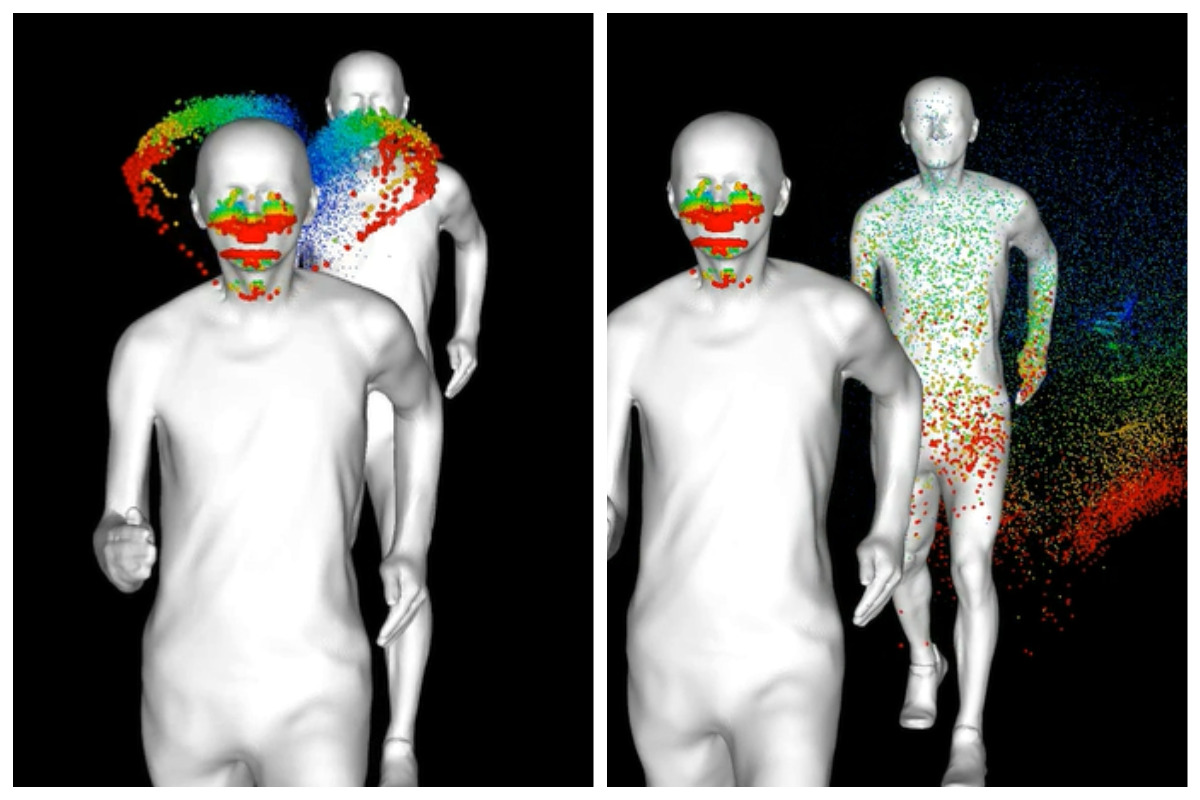
New research suggests standing even the recommended distance behind a runner or walker with Covid-19 can put you at risk of inhaling their exhaled droplets due to a slipstream effect.
The Belgian study however shows that walking, jogging or cycling slightly to the side of people avoids breathing in the air people exhale as they are moving.
So if you have been giving passers-by a wide berth – it’s not as mad as it looks. And exercise-phobes sharing this study because you are threatened by outdoor exercise as much as we are are missing the point – the study author was keen to explain to us that jogging and cycling are good for you – being directly behind someone rather than to their side can expose you to their breath – whether walking onto public transport or pushing a shopping trolley full of toilet paper and cake.
The simulations by researchers from KU Leuven, in Belgium, and Eindhoven University of Technology, in the Netherlands, use aerodynamic modelling usually used for sports or vehicle research.
The research has serious consequences for those choosing to keep safe with social distancing while doing exercise outdoors or, as the study authors told The London Economic, even walking behind people on the pavement or on public transport. The modelling suggests standing 1 – 2 metres apart – the recommended distance in most countries is safer, but placing yourself into the flow of air directly behind someone moving means you could be inhaling moisture they are exhaling.
After the study went viral on Thursday evening Professor Bert Blocken of Eindhoven University of Technology and KU Leuven in Belgium, was keen to stress to The London Economic: “(1) This is an aero[dynamics] study, not virology. We determined the distances needed when walking, running, cycling to have similar droplet exposure as 1.5 m when standing still. (2) We want to support running/cycling.”
The simulation and animations that went with it caused controversy after going – please excuse the phrase – viral on Thursday. This is because, like other studies on the spread of Covid-19 that are spread on social media even faster than the global pandemic itself, the research has not been peer reviewed before being published.
Professor Blocken said the paper was rushed into the public domain because the authors considered it “unethical” to hold back results from the public for several months while the Coronavirus pandemic continues to become a health crisis:
“A few people criticize this study has not been peer reviewed. Seriously? Crisis is world-wide, situation urgent, people are dying, economy crumbling. Should the public wait for months until peer review process is finalized?”
He added: “It was a race against clock to get results ready, confirmed, validated & animated. Not having full article yet = collateral damage for us wanting to communicate to public asap. Mind you: we validated with wind tunnel & ensured quality.”
Professor Blocken also warned against misinterpreting the study, adding: “Cycling & running are not big risks for #COVID19 spread. But moving closely in slipstream is. This holds everywhere, also when walking in supermarkets, shops, etc. No need at all to ban running or cycling.”
The solution the study found, is to stagger people – to walk, jog, cycle or run to the side of other people out and about.
“If someone exhales or coughs while jogging, those droplets remain in the air. The person who just runs behind you – in the so-called slipstream – then walks through that cloud of drops,” Bert Blocken, professor of aerodynamics at the universities, told Het Laatste Nieuws, a Dutch language newspaper based in Belgium.
“The slipstream is the zone that arises right behind a person when they are walking or cycling, and which pulls the air a bit along with this moving person, as it were.
“Cyclists like to use it during an escape, because then they have to put in much less effort. But someone who walks or walks also has such a slipstream. We have seen that no matter how that zone forms, droplets end up in that air stream. So it’s best to avoid that slipstream at the moment.”
In a footnote on the white paper, Professor Blocken added the caveat: “currently the subject of intensive debates between scientists world‐wide—is to what extent the residue of micro‐droplets with the virus, after evaporation, still carries an infection risk. Further virology research should shed more light on this issue.”
There is still much research and debate on what is a significant viral load of the potentially deadly virus.